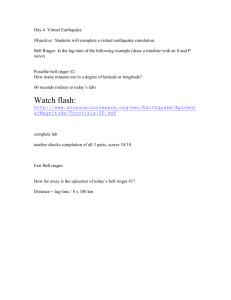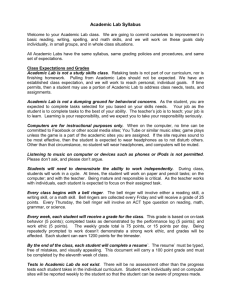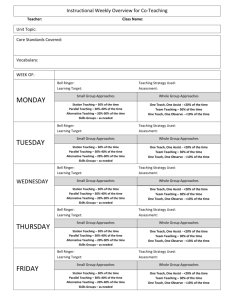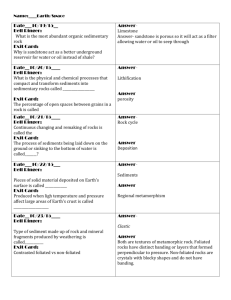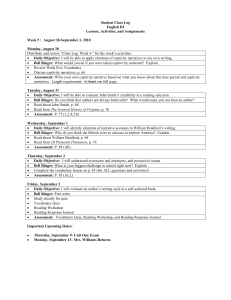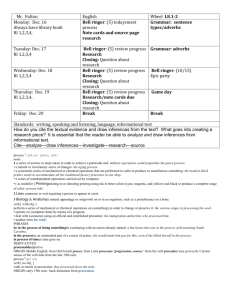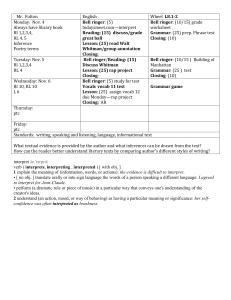Lesson Plan for Courage Unit - Allen County Schools Instructional
advertisement
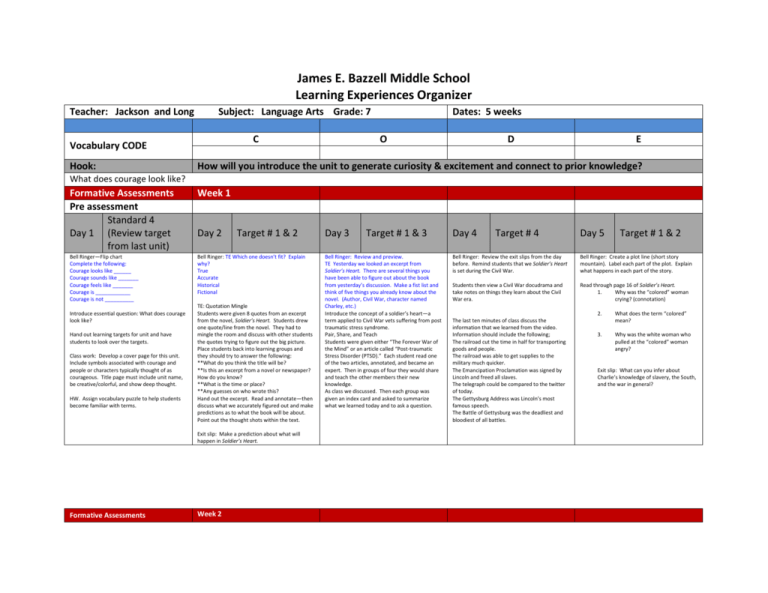
James E. Bazzell Middle School Learning Experiences Organizer Teacher: Jackson and Long Subject: Language Arts Grade: 7 C Vocabulary CODE Hook: Dates: 5 weeks O D E How will you introduce the unit to generate curiosity & excitement and connect to prior knowledge? What does courage look like? Formative Assessments Pre assessment Standard 4 Day 1 (Review target from last unit) Week 1 Bell Ringer—Flip chart Complete the following: Courage looks like ______ Courage sounds like _______ Courage feels like _______ Courage is ____________ Courage is not __________ Bell Ringer: TE Which one doesn’t fit? Explain why? True Accurate Historical Fictional Introduce essential question: What does courage look like? Hand out learning targets for unit and have students to look over the targets. Class work: Develop a cover page for this unit. Include symbols associated with courage and people or characters typically thought of as courageous. Title page must include unit name, be creative/colorful, and show deep thought. HW. Assign vocabulary puzzle to help students become familiar with terms. Day 2 Target # 1 & 2 TE: Quotation Mingle Students were given 8 quotes from an excerpt from the novel, Soldier’s Heart. Students drew one quote/line from the novel. They had to mingle the room and discuss with other students the quotes trying to figure out the big picture. Place students back into learning groups and they should try to answer the following: **What do you think the title will be? **Is this an excerpt from a novel or newspaper? How do you know? **What is the time or place? **Any guesses on who wrote this? Hand out the excerpt. Read and annotate—then discuss what we accurately figured out and make predictions as to what the book will be about. Point out the thought shots within the text. Exit slip: Make a prediction about what will happen in Soldier’s Heart. Formative Assessments Week 2 Day 3 Target # 1 & 3 Bell Ringer: Review and preview. TE Yesterday we looked an excerpt from Soldier’s Heart. There are several things you have been able to figure out about the book from yesterday’s discussion. Make a fist list and think of five things you already know about the novel. (Author, Civil War, character named Charley, etc.) Introduce the concept of a soldier’s heart—a term applied to Civil War vets suffering from post traumatic stress syndrome. Pair, Share, and Teach Students were given either “The Forever War of the Mind” or an article called “Post-traumatic Stress Disorder (PTSD).” Each student read one of the two articles, annotated, and became an expert. Then in groups of four they would share and teach the other members their new knowledge. As class we discussed. Then each group was given an index card and asked to summarize what we learned today and to ask a question. Day 4 Target # 4 Day 5 Target # 1 & 2 Bell Ringer: Review the exit slips from the day before. Remind students that we Soldier’s Heart is set during the Civil War. Bell Ringer: Create a plot line (short story mountain). Label each part of the plot. Explain what happens in each part of the story. Students then view a Civil War docudrama and take notes on things they learn about the Civil War era. Read through page 16 of Soldier’s Heart. 1. Why was the “colored” woman crying? (connotation) The last ten minutes of class discuss the information that we learned from the video. Information should include the following; The railroad cut the time in half for transporting goods and people. The railroad was able to get supplies to the military much quicker. The Emancipation Proclamation was signed by Lincoln and freed all slaves. The telegraph could be compared to the twitter of today. The Gettysburg Address was Lincoln’s most famous speech. The Battle of Gettysburg was the deadliest and bloodiest of all battles. 2. What does the term “colored” mean? 3. Why was the white woman who pulled at the “colored” woman angry? Exit slip: What can you infer about Charlie’s knowledge of slavery, the South, and the war in general? Day 6 Target # 1 & 7 Bell Ringer: How has Charlie’s thinking about war changed from when he lied about his age to sign up to now—after the first battle? Day 7 Bell Ringer: 1. Review yesterday’s exit slips. Discuss the following (on a flip chart) 1. What influenced Charley to be a part of the Union Army? 2. Which element of the exposition has not had an impact on Charlie? 3. There are several conflicts in Soldier’s Heart. Name two possibilities. 4. What happens in the rising action of any story? What does knowing that tell us about what Charlie will go through? 2. TE: Add the following terms to your vocabulary notebook: Onomatopoeia, idiom, irony, personification, literal, and non-literal. 6. 3. 4. 5. Target # 1 & 4 & 8 Look back over chapter four, “Bull Run,” on page 21. If this chapter had music in the background what kind of music would it be? Explain. 2. What kind of mood (the way the listener feels) would the music create? The exposition is the beginning of the story, when the setting and characters are established. What chapter did that happen in the novel? Genre means type or kind. What genre is Soldier’s Heart? Good writing will have multiple themes. Think of a possible central idea for Soldier’s Heart. Explain why the author chose to have Charlie be so young in this story? Read from novel Look back at page 6. Why is the comment, “It would all be over by fall,” an example of irony? Find the simile on the first full paragraph on page 15. Find another example of a simile from the top of page 13. Find an idiom on page 3—last full paragraph. Continue reading from Soldier’s Heart. Exit slip: Create a simile, personification, or idiom for Charley’s thoughts at this time. Week 3 Formative Assessments Day 8 Target # 1,7,8 Day 9 Target # 1, 4 Bell Ringer: Girls do odds, boys do evens: 1. How has Charlie’s thinking about the possibility of his own death changed since his first battle? 2. What (idea or thinking) influenced Charley and the other soldier to “farm” the chickens, pigs, and cows as they marched south? 3. Pg. 44, bottom paragraph—What synonym in the first sentence helps you determine the meaning of dysentery? 4. Why is the story of Nelson important to the central ideas developed in Soldier’s Heart? Bell Ringer: TE Fist List –draw a hand and label it character/personality traits. In the fingers answer the question. . . How do you determine what a new classmate’s personality is like when you first meet them? Assign writing: Write a letter to the Nelson family and express your sympathy. Remember your audience. Consider the salutation, body, and closing. Exit slip: Describe how Charley’s character traits have changed throughout the portion of the book we have read so far. What events influenced Charley and changed his personality? Hand out list of various character traits and glue into notebook. Then examine several flip charts where students are looking at the nonverbal communication of individuals. Annotate an excerpt from the novel where we look for clues to Charley’s character. Day 10 Target # 7 Bell Ringer: Identify the figurative language in each sentence: 1. Charlie was an animal, slashing, and hacking. 2. His legs forced him to walk across the meadow. 3. The bullets fell like a lightening storm all around him. 4. Splat, the bullet tore into his friend, Nelson. 5. If he signed up at Winona, someone would spill the beans about his age. Complete the novel. Take comprehension test. Share in class. Day 11 Target # targets 1-5 Pause Day – students will complete the right hand side of their pretest to determine who goes to the enrichment group and who works to learn targets one through five. Enrichment group: choose one of the following battles or individuals to research: Battle of Perryville Newton Station Abraham Lincoln Jefferson Davis General George McClellan Ulysses S. Grant Robert E. Lee Day 12 Target # 1 & 4 Bell Ringer: TE Add the following terms to your vocabulary notebook: Primary source and secondary source. View a list of slave births in Allen County from 1852—1861 (public county data) Students will then examine a slave bill of sale, a fictional story, and a soldier’s account of the Battle of Perryville. Students annotated and read using workshop model and reciprocal reading. HW: answer questions that cover all three documents. Day 13 Target # 3 &5 Bell Ringer: Three way tie; lsetting, characters, and conflict. When you think about Soldier’s Heart, which scene do you remember most/best? Without looking back at the book, recreate that scene. What do you hear, see, smell, feel, taste? What was the imagery? Hand out “First Minnesota Volunteer Infantry Regiment” and “Death of Charles E. Goddard” from The Winona Daily Republican. Each person should read one chunk and highlight new information about Charley Goddard as you find it. You will share this new information with your group. Students will then read their imagery and other students will guess the scene. On the bottom half of card, answer this question. What historical facts did Gary Paulsen use to create that imagery? Read “Author’s Note” taken from page 103 of novel. Highlight areas where Paulsen says that he used literary license to create this story. Why do authors sometimes need to use literary license? Targets 6 Bell Ringer: TE Add to your vocabulary notebook the following: Allusion, biblical, literary, and mythological. Discuss and explain different types of allusions. Ask: Why would an author use allusions? Hand out the text, Narrative of the Life of Frederick Douglass and American Slave, Written by Himself. Students will work in pairs and reciprocal read for meaning. This is a rather difficult text and will need more than one examination. Once students read and annotate, they will then go back and highlight all allusions and identify the type. Exit slip: an allusion is _________ Day 18 Targets 6 Bell Ringer: Three-way tie: mythological, biblical, and literary. Review synonyms, antonyms, analogies, and how they are used as context clues. Students will then work through examples from Soldier’s Heart. They will identify the type of context clue and underline the key words that gave the clue and write their own definition based on the clues. Check as a class. Exit slip: Authors use several different context clues to help us understand difficult words. What are the three ways we have examined today? Target # 1,3, 5 Bell Ringer: Answer the question below on a note card. Then explain Literary license (when authors change factual information a bit to make it fit in their fictional story. Day 17 Day 14 Day 19 Targets 1, 2, 3 & 4 Bell Ringer: Boggle—Review learning targets and then list everything from our unit that you have learned. Time is three minutes. Winner is playing for a new pencil and bookmark. Then get with your learning partner and compare list and add anything you have omitted. Figurative Language Activity: Skim through the book, Soldier’s Heart, and find examples of figurative language. Give the example, give the type of language, and give the page you found it. Comprehension menu: Mastery— list 4 historical facts Paulsen used, Interpersonal—Would you be able to do what Charley did when he loaded the gun for Nelson? Explain; Regroup as a class and discuss: Did Paulsen accurately portrays Charles Goddard in Soldier’s Heart? Exit Slip—You are Gary Paulsen. You want to write a historical fiction book about the Civil War. You know that there are two central ideas you want your readers to get: “War affects every person involved in a horrible way.” And “We should be aware that a huge number of soldiers both past and present suffer from PTSD.” Based on your research, you have chosen to write your novel called, Soldier’s Heart based on Charles E. Goddard from the First Minnesota Volunteers. Give three reasons that you have chosen Charley to be your main character. Why does his real life fit what you want to tell about in your book? Day 20 and 21 Test—Students are given two fresh texts. “Immigration in the Gilded Age” and “A Surprise for Rosie.” These are grade level texts but several pages long (4 ½). Texts are from Crosswalk. Students must read and annotate texts before handed the test. Test includes m/c, short answer, and extended response. Day 15 &16 Target # 1, 3, 4 Students will view The Horse Soldiers. This is an older movie set during the Civil War. This reenacts the Battle of Newton Station that took place in Mississippi. This is one Union companies attempt to eliminate the Confederate stronghold in Newton Station. --Students will note comparisons between things we have read, both fictional and non-fictional, and discuss how historical facts are used to create the background of the story. --Where did the writers of this movie use literary license? --What was the central idea? Day 22 Hand back m/c and short answer. Go over these and then offer Target Practice/reteach opportunities. Understanding—Either prove or disprove that Charley had Soldier’s Heart; Self-Expressive—Use at least two details that would have made this story better.
